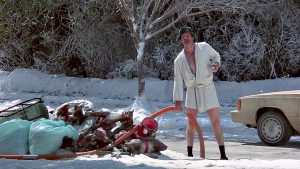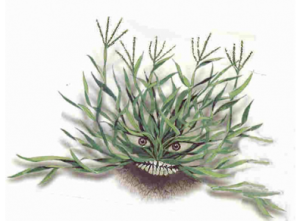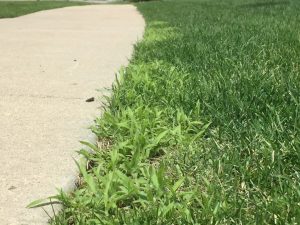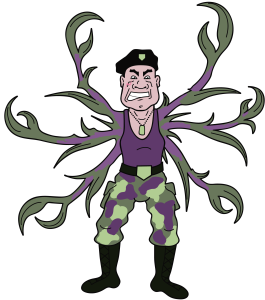Cary’s Corner
Crabgrass: The Cousin Eddie of Weeds
🗓️ Updated July 2025
 Crabgrass. We all hate it. It’s the Cousin Eddie of weeds.
Crabgrass. We all hate it. It’s the Cousin Eddie of weeds.
If you’ve ever seen Christmas Vacation, you know exactly what I mean—he shows up uninvited, parks his rust-bucket RV in your driveway, eats all your food, and refuses to leave no matter how many hints you drop.
That’s crabgrass in your lawn. It’s like Clark’s unwanted Jelly of the Month Club… “the gift that keeps on givin’ the whole year.”
How We Prevent Crabgrass
At ClassicLawns, we apply two rounds of premium pre-emergent weed control in early spring. This helps stop crabgrass—and its rowdy cousins like foxtail, goosegrass, and barnyard grass—before they ever get started. These treatments are highly effective and give us about 95% control in a typical year. That’s an “A” in our gradebook.
But it’s not a 100% guarantee.
Pre-emergents only work on grassy weeds before they germinate. There’s no such thing as a product that prevents broadleaf weeds (like clover or dandelions) from popping up—you can only treat those after they emerge.
How Pre-Emergents Actually Work
Crabgrass seeds start germinating when soil temps hit 53°F for several days in a row. Our pre-emergent treatments form a protective barrier in the top layer of your soil. Think of it like an invisible blanket: when a crabgrass seed tries to grow and sends out a root—it hits the barrier and dies.
Simple enough. But here’s the catch: a lot can disrupt that blanket.
What Causes Crabgrass Breakthrough?
We use the best products, applied at the right time, and at the correct rate. So why does crabgrass still show up sometimes?
Here’s the short list of usual suspects:
Heavy Spring Rains – Saturated soil leads to increased bacterial activity, which breaks down pre-emergents early.
Warm Spring Soil Temps – Accelerates the breakdown of the barrier.
Cool Spring Soil Temps – Delays crabgrass germination until the barrier starts wearing off.
Thin or Damaged Turf – Bare spots, high-traffic areas, or heat zones (along curbs, sidewalks, and driveways) allow crabgrass to sneak in.
Excessive Thatch – Acts like a sponge and keeps the pre-emergent from reaching the soil.
Delayed Germination Flushes – Drought or erratic weather can cause crabgrass to germinate after the product wears off.
High Weed Pressure – One crabgrass plant can produce 1,000+ seeds. Even 5% breakthrough means 50 new plants.
Barrier Disruption – Digging, edging, pets, sprinkler repair, or even drought cracks can break the barrier.
So yeah—even when we do everything right, Mother Nature and Cousin Eddie still like to throw curveballs.
 How You Can Help Us Win the Fight
How You Can Help Us Win the Fight
Here’s how to be a co-captain in the war against weeds:
Mow High – Fescue is happiest when cut at 3.5″–4″. Taller grass shades the soil and chokes out weed seeds.
Water Wisely – Aim for 1″ per week. Not enough = thin turf. Too much = barrier breakdown + disease.
Core Aerate Annually – Helps control thatch, strengthens roots, and gets nutrients deeper into the soil.
Fertilize Right – That’s our job. We use slow-release, seasonally timed fertilizer to feed your lawn without overdoing it.
Keep Pests in Check – Grubs, fungus, and other lawn bullies weaken turf, leaving gaps for weeds to move in.
 When Crabgrass Does Show Up
When Crabgrass Does Show Up
Once Col. Crabgrass and his troops show up and running, it’s very hard to kill without hurting your good grass. Why? Because crabgrass is a close cousin to fescue. Most treatments either burn everything or just make crabgrass sick without fully eliminating it.
Some of the new products we use do a better job than what was available in years past, but mature crabgrass is still a tough opponent—even for Grassman.
The good news? Crabgrass is an annual.
It grows from seed, lives a season, and dies with the first frost. As temps drop in fall, it fades, and your good grass starts to rebound. Fall rains and cooler nights help your lawn bounce back—especially if you overseed.
Final Thoughts
Crabgrass isn’t a sign of failure—it’s a sign of weather, pressure, or timing. And just like Cousin Eddie, it sometimes sneaks in despite your best efforts.
The solution? Build a strong team. Great turf, proper mowing and watering, a little help from ClassicLawns—and next spring we’ll be ready to shut the door on ol’ Eddie once and for all.
If you’ve got questions, concerns, or if your lawn’s looking more full of crabgrass than Cousin Eddie’s RV tank… give us a call. We’re always here to help keep things clean, green, and Cousin Eddie-free.
– Cary Carlson
Owner | ClassicLawns
417-812-5321
